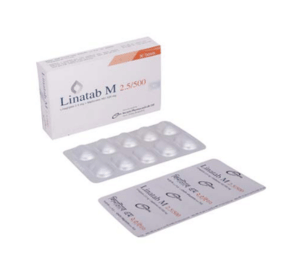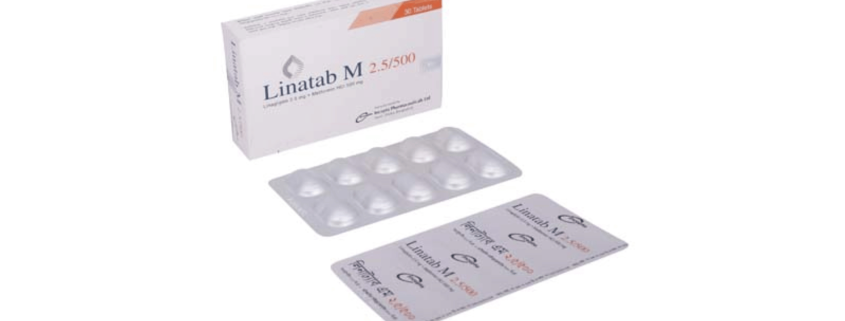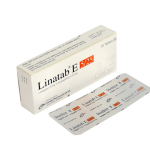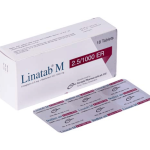Linatab M(Linagliptin + Metformin HCl)

Therapeutic Group: Anti Diabetic
Presentation
Linatab M 2.5/500: Each tablet contains Linagliptin 2.5 mg + Metformin HCl BP 500 mg.
Linatab M 2.5/850: Each tablet contains Linagliptin 2.5 mg + Metformin HCl BP 850 mg.
Linatab M 2.5/1000: Each tablet contains Linagliptin 2.5 mg + Metformin HCl BP 1000 mg
Description
LINATAB M is a combination of 2 oral antihyperglycemic drugs with complimentary mechanism of action to improve glycemic control in patients with type-2 diabetes mellitus: Linagliptin, a Dipeptidyl Peptidase-4 (DPP-4) inhibitor and Metformin, a member of the biguanide class.
Linagliptin is a dipeptidyl peptidase-4 (DPP-4) inhibitor, which exerts its action by slowing the inactivation of incretin hormones. Incretin hormone levels are increased in response to a meal. When blood glucose concentrations are normal or elevated, incretin hormones increase insulin synthesis and release from pancreatic beta cells. incretin hormones also lowers glucagon secretion from pancreatic alpha cells, leading to reduced hepatic glucose production.
Metformin decreases hepatic glucose production, decreases intestinal absorption of glucose, and increases peripheral glucose uptake and utilization.
Indications
Indication:
Linagliptin + Metformin combination tablets are indicated as an adjunct to diet and exercise to improve glycemic control in adults with type 2 diabetes mellitus when treatment with both Linagliptin and Metformin is appropriate.
Important Limitations of Use:
– Not for treatment of type 1 diabetes or diabetic ketoacidosis, as it would not be effective in these settings.
– Has not been studied in patients with a history of pancreatitis.
Dosage & Administration
The dosage of Linagliptin + Metformin combination should be individualized on the basis of both effectiveness and tolerability.
Dose escalation should be gradual to reduce the gastrointestinal side effects asoociated with Metformin use.
The maximum recommended dose is 2.5 mg Linagliptin/1000 mg Metformin twice daily.
Should be given twice daily with meals.
Recommended starting dose:
– In patients currently not treated with Metformin, initiate treatment with 2.5 mg Linagliptin/500 mg Metformin hydrochloride twice daily
– In patients already treated with Metformin, start with 2.5 mg Linagliptin and the current dose of Metformin taken at each of the two daily meals
(e.g., a patient on Metformin 1000 mg twice daily would be started on 2.5 mg Linagliptin/1000 mg Metformin hydrochloride twice daily with meals).
– Patients already treated with Linagliptin and Metformin individual components may be switched to Linagliptin + Metformin combination containing the same doses of each component.
Concomitant Use with an Insulin Secretagogue (e.g., Sulfonylurea) or with Insulin:
When Linagliptin + Metformin combination is used in combination with an insulin secretagogue (e.g., sulfonylurea) or with insulin, a lower dose of the insulin secretagogue or insulin may be required to reduce the risk of hypoglycemia.
Side Effects
– Adverse reactions reported in 5% of patients treated with Linagliptin + Metformin combination more commonly than in patients treated with placebo are nasopharyngitis and diarrhea
– Hypoglycemia was more commonly reported in patients treated with the combination of Linagliptin + Metformin along with SU compared with those treated with the combination of SU and Metformin
Precautions
– Lactic acidosis can occur due to Metformin accumulation during treatment with Linagliptin + Metformin combination and is fatal in approximately 50% of cases
– Patients should be cautioned against excessive alcohol intake when taking Linagliptin + Metformin combination since alcohol potentiates the effects of Metformin on lactate metabolism
– It is not recommended in hepatic impairment or hypoxic states
– Contraindicated in renal impairment. Because risk of metformin accumulation and lactic acidosis increases with the degree of renal impairment. Ensure normal renal function before initiating and at least annually thereafter.
– There have been postmarketing reports of acute pancreatitis, including fatal pancreatitis. If pancreatitis is suspected, promptly discontinue this drug
– Temporarily discontinue this drug in patients undergoing radiologic studies with intravascular administration of iodinated contrast materials or any surgical procedures necessitating restricted intake of food and fluids
– Hypoglycemia: When used with an insulin secretagogue (e.g., sulfonylurea (SU) or insulin, consider lowering the dose of the insulin secretagogue or insulin to reduce the risk of hypoglycemia
– Vitamin B12 deficiency: Metformin may lower vitamin B12 levels. Monitor hematologic parameters annually.
– Arthralgia: Severe and disabling arthralgia has been reported in patients taking DPP-4 inhibitors. Consider as a possible cause for severe joint pain and discontinue drug if appropriate.
Use in Pregnancy & Lactation
Pregnancy:
Pregnancy category B.
There are no adequate and well-controlled studies in pregnant women. Linagliptin + Metformin combination tablets should be used during pregnancy only if clearly needed.
Nursing Mothers:
Caution should be exercised when Linagliptin + Metformin combination is administered to a nursing woman.
Pediatric Use:
Safety and effectiveness of Linagliptin + Metformin combination in pediatric patients under 18 years of age have not been established.
Geriatric Use:
Linagliptin is minimally excreted by the kidney; however, Metformin is substantially excreted by the kidney. Considering that aging can be associated with reduced renal function, Linagliptin + Metformin combination should be used with caution as age increases.
Drug Interaction
– Cationic drugs (e.g., Digoxin, Morphin etc) that are eliminated via the proximal renal tubular system may interact with Metformin. So careful patient monitoring and dose adjustment of Linagliptin + Metformin combination or interfering drugs is recommended in patients taking cationic medications.
– Use Carbonic Anhydrase Inhibitors (e.g., Topiramate) with caution in patients treated with Linagliptin + Metformin combination, as the risk of lactic acidosis may increase
– The efficacy of Linagliptin may be reduced when administered in combination with a strong P-glycoprotein/CYP3A4 inducer (e.g., Rifampin). Use of alternative treatments (not containing Linagliptin) is strongly recommended.
Over Dose
In the event of an overdose with Linagliptin + Metformin combination, contact the Poison Control Center. Employ the usual supportive measures (e.g., remove unabsorbed material from the gastrointestinal tract, employ clinical monitoring, and institute supportive treatment) as dictated by the patient’s clinical status. Removal of Linagliptin by hemodialysis or peritoneal dialysis is unlikely. However, Metformin is dialyzable with a clearance of up to 170 mL/min under good hemodynamic conditions. Therefore, hemodialysis may be useful partly for removal of accumulated Metformin from patients in whom Linagliptin + Metformin combination overdosage is suspected.
Linagliptin
During controlled clinical trials in healthy subjects, with single doses of up to 600 mg of Linagliptin (equivalent to 120 times the recommended daily dose), there were no dose-related clinical adverse drug reactions. There is no experience with doses above 600 mg in humans.
Metformin
Overdose of Metformin has occurred, including ingestion of amounts greater than 50 grams. Hypoglycemia was reported in approximately 10% of cases, but no causal association with Metformin has been established. Lactic acidosis has been reported in approximately 32% of Metformin overdose cases.
Storage
Store at 25°C. Protect from exposure to high humidity. Store in a safe place out of reach of children.
Commercial Pack
Linatab M 2.5/500: Each box contains 3 blister strips of 10 tablets
Linatab M 2.5/850: Each box contains 5 blister strips of 4 tablets
Linatab M 2.5/1000: Each box contains 5 blister strips of 4 tablets



